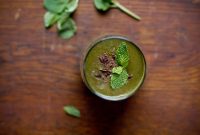Nutritionist explains how to make the perfect smoothie
Nutritionist explains how to make the perfect smoothie
Want a nutritious lunch or snack without too much hassle? And who doesn’t want to?! Then try smoothies and you won’t go wrong.
You can endlessly come up with different options for smoothies. You can combine fruits, vegetables, add protein supplements and healthy fats. And there’s no better way to recharge after a workout or cool off on a hot day than with a cold smoothie.
Often the most nutritious smoothie is the one you make yourself. Here are the basic steps, ingredients, and tips for making a healthy, delicious, balanced smoothie.
1. Choose a foundation
Everyone can make their own unique smoothie, but they all have a base that makes up the bulk of the drink. Most smoothies use fruits, vegetables, or a combination of the two as the base. However, fruits provide natural sweetness and make smoothies more nutritious.
Delicious fruits
All fruits contain carbohydrates, fiber, and various vitamins and minerals. Berries are a popular smoothie addition because they contain antioxidants that can help protect cells from free radical damage, and their tiny seeds give the smoothie a nice texture.1
Bananas and tropical fruits like pineapple, mango and kiwi are also great in smoothies. Watermelon and melon are also good smoothie options, but due to their high water content, they tend to be thinner.
There are no forbidden fruits, so choose the combination that you like the most.
More vegetables
Smoothies should also include vegetables. Although vegetables are often eaten as part of savory dishes, adding them to smoothies is a great way to saturate the body with nutrients and get a satisfying serving for those who generally do not eat a lot of vegetables.
Leafy greens like kale and spinach are popular smoothie additions and pair easily with the fruit’s natural sweetness. You can also add beets, celery, cucumber and carrots to smoothies.

Most of the time, the vegetables will change the color of the smoothie but not significantly change the taste, so you end up with really nice smoothies with a high nutritional value. Start with a small portion of vegetables and gradually add more to reach your desired flavor and color when in doubt.
Vegetable powders
Vegetable powders can be a great option if you don’t have enough fresh vegetables or prefer not to add them to smoothies. For example, beets are rich in nutrients, but not everyone likes their taste.
Beet powder can simply be mixed with water and consumed before a workout or added to breakfast smoothies. A small amount of beetroot powder in a smoothie boosts the fiber and antioxidant content and provides the drink with a natural source of nitric oxide, which can be very beneficial for the circulatory system.2
Try any powdered greens that can be used in place of or in addition to vegetables in smoothies. Many of these powders are high in dark leafy greens like kale and wheat germ, as well as other botanicals like spirulina.
These dark green leafy vegetables are an excellent source of vitamin K, a nutrient that is good for circulatory and bone health and is not found in other foods. substances.
2. Choose a Protein Source
Smoothies can be a great source of essential nutrients, but it takes diligence to make a complete drink. A fruit and vegetable smoothie base is a great source of carbohydrates and other nutrients like fiber and antioxidants, but is very low in fat and protein. Fruit provides most of the carbs in a drink, so let’s look at smoothie protein sources.
Protein and Collagen Powders
Protein powders are a popular and convenient way to add protein to smoothies. Since they come in a wide range (whey, soy, pea and brown rice proteins), there is a protein powder for everyone. Regardless of dietary restrictions, there is a protein powder that will meet your specific needs.
In addition to smoothies, protein powder can be diluted with water and consumed for post-workout recovery, or added to meals and baked goods. Always have a container of protein powder handy for easy adding to many meals and snacks. Alternatively, collagen powder also contains protein and can be used in addition to or in place of protein powder in smoothies.
Greek yogurt
It is best to use unflavored yogurt with no added sugar. And even if you don’t like the natural bitterness of plain yogurt, it will be offset by fruit in a smoothie.
In addition, a liquid can be a source of protein, and many fats that can be included in smoothies can also contain protein. More on this later.
3. Fats are an essential nutrient
Fats are an important nutrient that increase satiety after meals and help the body absorb fat-soluble vitamins. Nuts, seeds, and nut creams are great additions to a smoothie, as they pack healthy fats and protein and add a unique flavor to your smoothie.

Ground flaxseeds or flaxseeds, chia seeds, and hemp seeds contain protein and anti-inflammatory omega-3 fatty acids, which are rarely found in plant foods.4 Like seeds, nuts also contain protein, fiber, and healthy fats. Whole nuts like walnuts, pecans, and macadamia mix well in smoothies, but you can also use nut cream for healthy fats.
4. Add a healthy twist
Thanks to fruits, vegetables, proteins and healthy fats, the drink is already rich in nutrients, but these additions can make smoothies even more nutritious:
Bee Pollen: Bee Pollen granules mix easily into smoothies without ruining the taste and help support immunity and liver health.5
Cocoa Nibs: Antioxidant-rich crushed cocoa beans add a light chocolate flavor to smoothies and help fight free radical damage.
Spirulina: This blue-green algae may support healthy cholesterol and blood pressure levels, and help control blood sugar levels in people with type 2 diabetes.6 Spirulina is often found in powdered greens, but can be added separately.
5. Choose a liquid
Once you’ve chosen all the solid ingredients, it’s time to add the liquid and blend them together. The liquid serves one main purpose – to emulsify and combine the dry ingredients. Yes, water can do the job, but there are many other liquids that add extra nutrients and flavor to give the drink the right consistency.
Try any kind of milk. For example, nut, soy, hemp, rice, oat, or regular. Your choice depends on personal preference and dietary needs.
When choosing a liquid, keep an eye on the sugar content in grams. Sugar is added to some flavored dairy products and milk substitutes. It’s always better to rely on the sweetness of the fruit in the smoothie rather than the added sugar.
Alternatively, depending on the flavor and level of caffeine you want in your smoothie, you can add coconut water, green tea, or coffee.
Get creative with the process
Be creative in making each individual smoothie based on your specific preferences. There are countless options to try depending on your mood, nutritional needs, and what fruits, vegetables, liquids, and sources of fats and proteins you have in your kitchen


